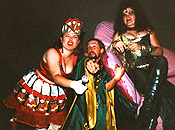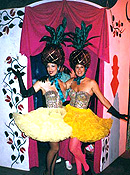The apparent parallels with our event intrigued me. Burning Man, of course, has never claimed the status of religion. The Man stands alone atop his temple-like pedestal, but no priests or hierophants are there to administer rites or interpret their meaning. When people ask what the Burning Man ultimately represents, we prefer to ask them what it means to them. However, I was most interested in the structure and operation of these ancient religions. They seemed to represent a kind of recipe by which virtually anything could be made to function interactively. Having studied the Mysteries and their rites of initiation, I compressed this idea into five simple rules. Looking through my show notes, I find I gave the following directions to participating artists.
- Recruit — Initiates must be actively sought out and recruited. Our approach to participation is proactive. Be prepared to proselytize, seduce or otherwise welcome the public into your cult.
- Initiate — Initiates must experience a trial, a test, perform a ritual action or undergo a rite. They must both act and be acted upon in some way that transforms their consciousness and prepares them to witness a mystery.
- Witness — Initiates must come before a mystery, access to which will be closely guarded. Mysteries should take the form of both a vision and a ceremonial rite — participants must again perform an action and in some way be acted upon.
- Sign — Initiates must be given a token or sign that represents their possession of secret knowledge and marks their separation from the uninitiated.
- Pledge — Initiates must take an oath not to reveal their privileged experience to others who do not possess such a sign or token.
Employing these five rules, we constructed a model cult that filled the principle exhibition space at SOMARTS. The following statement is taken from the instructions that I wrote for performers.
THE COURT OF CRUEL MISTRESS GAIA
The Court of Gaia takes its place with last year’s featured presentation, the Throne of HELCO. Like HELCO, it is farce. It represents one of our time-tested techniques. When people can be made to laugh, they surrender their reservations. With nothing to lose, they suspend disbelief and become more available to experience. The primal and surreal thrive in this environment. Under cover of laughter, profoundly irrational truths can sneak in. Our shows are about immediate experience. We satirize ideology.
 The premise of the Court is simple. Gaia rules the Earth. She is an all-powerful despot. Her court of cowering fruits, nuts and vegetables tremble before her and, as with any court, this will represent a highly stratified and extremely status conscious social order. Nuts reign atop this hierarchy, followed by the fruits who, in turn, are lords over the many vegetables. Gaia’s underlings exist to please and placate Her. They seek to bask in the appropriated glow of power. She is quick to anger, easily bored, and difficult to amuse. Gaia is a spoiled diva, an unrelenting egoist. The highest honor that can be bestowed on anyone in court — and the surest avenue to preferment — is the coveted privilege of kissing her ass.
The premise of the Court is simple. Gaia rules the Earth. She is an all-powerful despot. Her court of cowering fruits, nuts and vegetables tremble before her and, as with any court, this will represent a highly stratified and extremely status conscious social order. Nuts reign atop this hierarchy, followed by the fruits who, in turn, are lords over the many vegetables. Gaia’s underlings exist to please and placate Her. They seek to bask in the appropriated glow of power. She is quick to anger, easily bored, and difficult to amuse. Gaia is a spoiled diva, an unrelenting egoist. The highest honor that can be bestowed on anyone in court — and the surest avenue to preferment — is the coveted privilege of kissing her ass.
When Gaia grows vexed, scapegoats must be found. Nuts will blame fruits and fruits will blame vegetables. Ultimately, everyone will blame the Lima Beans. If Gaia favors anyone, they will behave insufferably toward everyone beneath them. Again, the Lima Beans, attired in padded costumes, will suffer most. When Gaia is bored, her courtiers will desperately seek out the court fool (embodied as the Grape). Tense moments will ensue as the Grape attempts to amuse his sovereign. Other potent powers in the court will include the Top Banana [the banana was played by Will Roger], the Maraschino Cherry, the Salted Cashew and his crony, the Beer Nut. Cabbage leaves (whose chore is to fan the Mistress) will be ubiquitous, and Celery Stalks, depressed by disfavor, will be given the opportunity to wilt at appropriate intervals. Gaia Herself will stride about in large green platform boots with foot-high soles.
 With the help of my assistant and collaborator on the Temple of Gaia, Dana Albany, much of this burlesque was realized, although Kim Leary, who played Gaia, was too sweet tempered to remain imperious. The Court conducted its hectic life before and upon an enormous temple built according to the proportions of a Mayan pyramid. The point of this ongoing performance was to initiate participants and lure them up the steep steps of this edifice and into a gorgeously appointed chamber. Upon parting a green velvet curtain, they confronted an enormous ass: the pimpled butt of arbitrary power. It loomed at them inside this enclosed space, bristling with fibrous hairs. This grotesque sculpture was fashioned out of fiberglass by Michael Christian. Participants were told to thrust their hands into the apparent anus of this body part, whereupon a concealed dispensing device deposited a chocolate-coated malted milk ball in their palm. This, then, was the mystery they beheld that furnished them their token.
With the help of my assistant and collaborator on the Temple of Gaia, Dana Albany, much of this burlesque was realized, although Kim Leary, who played Gaia, was too sweet tempered to remain imperious. The Court conducted its hectic life before and upon an enormous temple built according to the proportions of a Mayan pyramid. The point of this ongoing performance was to initiate participants and lure them up the steep steps of this edifice and into a gorgeously appointed chamber. Upon parting a green velvet curtain, they confronted an enormous ass: the pimpled butt of arbitrary power. It loomed at them inside this enclosed space, bristling with fibrous hairs. This grotesque sculpture was fashioned out of fiberglass by Michael Christian. Participants were told to thrust their hands into the apparent anus of this body part, whereupon a concealed dispensing device deposited a chocolate-coated malted milk ball in their palm. This, then, was the mystery they beheld that furnished them their token.
The most intriguing aspect of this show, however, was probably not the spectacle that we created. Having posited five simple rules that served to frame interaction, it became apparent that these could be applied to any kind of content. The artists and performers who became the Court of Gaia were recruited from a group of people whom we knew. Now, we invited other people to produce their own cults in an adjoining hall. This, indeed, was very Burning Man-like; these were virtual theme camps, and some of them were quite elaborate. Harley Dubois coordinated this effort, just as she does in the desert today. We had invented a veritable engine by which a formal set of rules could generate unique and spontaneous interactions.

